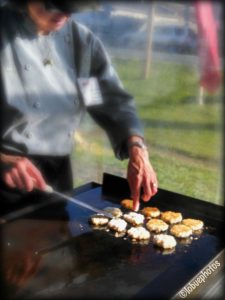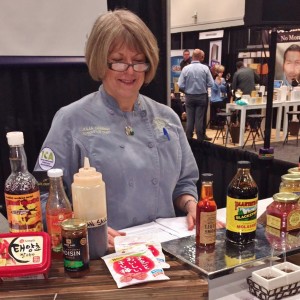Our industry has changed a lot in the last twenty years. With the popularity of chefs increasing and the public’s demand for better food growing as a result of the advent of primetime food television, restaurants and other foodservice providers have been require to step up our game. But while the number of women in the kitchen is on the rise, we are still, in many cases, considered “that girl”, rather than as a member of the team. Now I am the first to say I am not a traditional feminist, and I don’t want any sort of special treatment or consideration based on my gender. I do, however, want to be on the team, rather than just some sort of mascot relegated to the sidelines.
I started cooking professionally (for money) when I was still in high school. My mother owned a diner in a small northern California town, and the entire family, with the exception of my five-year-old baby sister, worked in the business. My middle sister loved working the counter and the dining room, visiting with the customers, while I preferred the kitchen. I started in the back room, on early morning prep, and quickly moved to the grill/griddle. My parents were liberal Californians, and so I was raised to believe that gender didn’t matter, as long as you could do the job as expected. I spent my weekends and evenings after school cranking out burgers, sandwiches and a weekly special family dinner menu. Dancing between the big flat top and the deep fryer, I developed a love of the adrenaline high of a busy service, allowing my mother to manager the all-important cash register.
When I went off to college, it was understood that I would pursue an academic degree, and get a “real” job, but I knew the best way to earn extra money was to work in a restaurant. I was just seventeen, and hit my first “wall”. “…I’m sorry honey, we can’t have you in the kitchen until after you are eighteen…wouldn’t you rather be a waitress?” This was especially frustrating since I saw boys my age doing vegetable prep and in the dish room. I waited impatiently until my eighteenth birthday, and much to my surprise, it made little difference. I was still lectured on how the kitchen was a hot and dangerous place, and girls were too delicate for the work. I finally managed to talk the manager of a local sandwich shop into hiring me for morning prep, since no one else seemed to be interested in that job, preferring the more visible sandwich maker positions. I showed up every morning at 6:00AM, cranked up the stove and the stereo and settled into six hours of slicing meats and vegetables, preparing the chili, steaming the roast beef and pastrami and setting up the twelve sandwich stations for the lunch shift. Afternoons, I went to classes, pursuing a degree in Business. I’d board the bus at 1:00P to ride downtown to campus, reeking of pastrami and clutching my free sandwich, which would become my dinner between afternoon and night classes. I worked that job for two years, until one day, I came in to find that they had hired a “chef” that would take over the prep duties. Of course he was a guy, barely older than I was, but wore a white cotton floppy hat and a dirty white chef coat, instead of my red cotton apron and baseball cap. After that, I stayed out of the kitchen, instead working as a waitress and eventually cocktail waitress as I tried to finish school. The money was better, and I was working nights and weekends instead of weekday mornings, so my social life improved greatly, but I still missed the kitchen.
I returned to the kitchen many years later, after twenty years of working as a sales and marketing manager in the high tech industry. I was burned out on the high stress world of being on call 24/7, when your beeper (and later your cell phone) would ring at 4:00AM with that all important call from a client in Asia. I started working for a catering company, first as a sales manager, then as operations manager. Part of our training was to work in all of the departments of the company, and I found myself clocking in at 4:00AM with the baker to work my first shift of my kitchen training. I fell right back into it like I had never left. I eventually opened my own catering company, and decided to pursue some traditional culinary education at a local community college and eventually at the Culinary Institute of America in the Napa Valley.
In almost every one of my classes, I was one of two or three women. My age and gender meant that most of the young men, who were line cooks and junior sous chefs decided that I was a “housewife” and did not belong in the class. Either that or I should be what they called a “pastry bunny”, a derisive term for the pony-tailed female pastry program students on the other side of the huge kitchen hall. I remember going to my Skills II instructor, well-known chef instructor that trained in the Swiss and German hotel system. I lamented that my kitchen lab partner treated me like his personal prep cook, relegating me to slicing vegetables while he worked the hot line. I didn’t want to be the complainer, just wanting to be treated as a team member and peer, but I was paying good money to learn, and I refused to be denied the opportunity to cook. Chef Dieter advised me to ignore what my partner was doing and choose which recipes I wanted to prepare; to come to class with my prep lists written, showing up before breakfast so as to get a head start and be deep in my work by the time my so-called partner showed up to class. I did, and on the last day of the class, when my partner ended up in the weeds, I stepped in and finished his saute work while he struggled to plate his dishes in time for service.
Even online, we seem to be the butt of all the jokes. In one forum recently, I disagreed with a male chef’s viewpoint on a situation, and found myself berated in a most graphic manner in a rant that went on to discuss bodily fluids and my relative value as a breeding sow. Thankfully, the group administrators (all men, by the way) stepped up and booted the troll out of the group. I am grateful for the level playing field of many of the online groups that I am a member of, as the sharing of inspiration and our work is a valuable tool in developing as a chef and culinary professional. Give us a chance to contribute, and the experience is richer for everyone.
It seems like every kitchen I show up to work in, the first assumption is that I should really be on pastry, or on the salad line. “Girls” aren’t strong enough, aren’t tough enough, take teasing too seriously, won’t stand up to the rigors of working the line. “Girls” aren’t fast enough, can’t take a joke, get their feelings hurt or will let you down. Let me tell you something, “boys”, girls are tougher than you think. “Girls” don’t quit, show up when we are expected to, aren’t afraid to ask questions, tell dirtier jokes than some of you do. Hell, many of us even understand and speak Spanish. It’s always a moment when I am working away, listening to the chatter around me, and inadvertently laugh at the punch line of some particularly vile joke, without even realizing everyone is speaking Spanish. The first time it happened, everyone just stopped dead in their tracks, the kitchen was silent, and every eye was on the “girl”. I have to admit, I loved the shock value. I also loved beating the guys at their own game.
Women in the kitchen don’t have to make themselves into men in order to fit in. I am not saying that the image of the tough “grill bitch” female chef is wrong. It’s just that like male chefs, female chefs come in all shapes, sizes and dispositions. As an executive chef today, with a largely female kitchen, I run a tough shift, but yet there is little shouting, and little or no abuse commonly found in male dominated kitchens. We crank out some amazing food under challenging circumstances, as many of our kitchens are in the field, literally in a field. There is still nothing like the rush of a challenging service, a plate up of multiple courses for 100+ guests, and when we are done, there is still a lot of butt-slapping, high-fiving, and a few well deserved “f’ yes’s!” As more women rise up the ranks, the dynamic of the kitchens will shift. No, we won’t make everyone stop swearing, we won’t make all of you wear pink aprons. Instead, we will hold the entire team equally accountable to the success or failure of service, just like our male peers. Like I said earlier, we don’t want to be special, we just want to be on the team, to suit up, show up, and kill it at service every time. So next time you are tempted to segregate the “girl” in your kitchen to the back room, give her a chance to show you what she’s made of. I suspect you’ll be pleasantly surprised.



